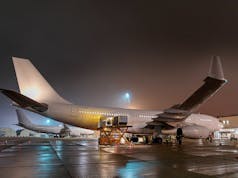Engineers from BAE Systems together with students from Cranfield University, have revealed a new technology concept – named Adaptable UAVs – which can alternate between the two different flight modes in the same mission.
When in rotary wing mode the UAVs can be launched and recovered from battlefields and docked on a special pole.
The Adaptable UAVs are a hybrid between fixed and rotary-wing aircraft, and would use adaptive flight control and advanced navigation and guidance software, which would allow the aircraft to benefit from the greater speed and range afforded to fixed-wing aircraft, before alternating to rotary-wing mode to hover and achieve vertical take-off and landing.
According to BAE Systems:
“This novel technology could allow UAVs to better adapt to evolving future battlefield situations and through working together in a swarm, tackle sophisticated air defences, as well as operating in complex and cluttered urban environments.
In the rotary wing mode of flight, the Adaptable UAVs can be easily and safely launched and recovered using a range of vehicles in dangerous environments that might be cluttered by personnel, other aircraft or vehicles. The pole constrains the lateral or sideways movement of the UAV when being launched or recovered so strong winds cannot dislodge them and avoids any damage to personnel nearby.
This is particularly important when recovering a UAV to the aft of a ship or a land vehicle. The pole’s gyro-stabilised element also ensures that it remains upright independently of the host vehicle’s orientation, which may be rolling if on a ship, or in the case of a land vehicle driving up or down a slope at the time of the launch or recovery.”
“The battlefield of the future will require novel solutions to meet emerging threats and to keep human operators safe wherever they may be’,” said Professor Nick Colosimo, BAE Systems’ Futurist and Technologist. “The Adaptable UAVs concept and related technologies are one of a number of concepts being explored through close collaboration between industry and students in academia.”
Professor Antonios Tsourdos, Head of the Centre for Autonomous and Cyber-Physical Systems at Cranfield University, said:
“Working with BAE Systems on the Cranfield University MSc in Autonomous Vehicle Dynamics & Control has provided a great opportunity for the students and research staff to explore a range of novel concepts and technologies.”













More CGI and sketches from BAE, do they have actually anything that is REAL ? It reminds me of the auto sector, producing drawing after drawing of outrageous looking concept cars that come to absolutely nothing.
I firmly believe the age of manned flight is coming to an end. There will always be a need for some manned missions, but the fleets will be much smaller. The real propellant behind such a dramatic change will be costs. To put it simply, conventional aircraft such as F35 will be too expensive even for the big players like US, China, and Russia by say 2030/40’s. As for everyone else, the price per unit will be prohibitive, resulting in smaller manned and increased automated drone systems of various size and function. Basically, the drone will form the backbone of most airforces by the early 30’s and will possibly achieve greater oprabilty due to not being concerned with G – forces, and other human impediments. Of course, this can only come about if costs are considerably cheaper than conventional manned craft alternatives.
I agree. When considering costs you need to factor in not only purchase price but also running costs. I would expect both pilot training and pay would be cheaper for drone pilots than in-situ pilots especially as drones get more and more on-board autonomous systems, and also the issues of keeping pilots current via sufficient real and simulated flying hours; again, in both cases I expect this would be something that would be cheaper for unmanned systems vs F35/Typhoon/etc pilots.
As our American friends say,’Out of harm’s way’ must have a significant impact on drone pilot pay structures. Keeping frontline pilots and navigators must weigh heavily on RAF budgets. The current process of pilot training must contribute to further cost that would otherwise go toward buying more drone capability.
Drone pilots won’t come cheap either, they too need training but again, would be considerably cheaper than burning thousands of gallons of aviation fuel in the process. I’m not privy to drone operational shortfalls, and where only a manned planes can operate, but the burning question remains, what are the alternatives?
One possible dilemma with adopting drones on mass, what planemaker will be interested in developing an advanced manned fighter (of F35 caliber) when the global market, will be considerably smaller?
Yes, the training and flight-hours thing is interesting. For an in-situ pilot it’s all very well doing lots of simulator hours but that is still no substitute for the real thing because that’s the only way to add the stress of knowing that if something bad happens to the plane then something bad happens to you.
For drone pilots the simulator could be the exact same chair that they sit in to fly combat or training missions, the only difference being whether the sensor imagery and pilot control inputs are being generated/processed by a real drone or by a computer simulation. That saves the cost of building the physical simulator cockpits. We should also remember that we are talking about 15-ish years from now (your reference to “by the early 30’s). We are already at the point where simulation technology is pretty much photo-realistic. By the early 2030s I think that simulation technology will be so good that in a blind test pilots will be completely unable to detect whether they are flying a simulation or a real drone.
True – but don’t tell the RAF. Without manned combat aircraft, they have no reason to exist as a separate service.
In a post earlier I intimated that a QE class carrier with a mixed fleet of manned/unmanned aircraft will be best for peer vs peers scenarios. I still firmly believe that politicians will be blinded by science and the supposedly massive cost savings of binning manned fighter/strike aircraft. The manufacturers will be advertising the mission capabilities, extended loiter times and low operating costs of the new wonder weapon.
Duncan Sandys, the 1957 Defence Minister, whose infamous white paper not only destroyed the British Aircraft Industry but more importantly decreed that all manned fighter aircraft would be replaced by missiles. This was famously debunked by a 1 Sqn Hawker Hunter flying low level over London as part of a pilot’s grievance to the MOD not recognizing the 50th Anniversary of the birth of the RAF, but also the massive defence underspend. during his demonstration he flew below the upper span of Tower Bridge. What was indicative of this stunt, was that none of the low level flying was captured on radar.
The upshot of this was that this would later become a key part of the RAF’s cold war strategy of a war with the Warsaw Pact, i.e. low level interdiction.
OK a drone is not a missile, but the method of remote control is the same, i.e. using a line of sight data link and in the case of drone bouncing the signal via satellites.
The Russians, Chinese, North Koreans and Iran have all recently shown there hands on their cyber hacking capabilities. There is still some dispute on how Iran managed to obtain the RG-170 Sentinel. Whatever the US claims, it is highly likely that the aircraft flight controls were hacked, as normally if an operator looses flight control they send a kill code to destroy the drone, this clearly didn’t work.
Therefore to place all you eggs in the drone basket is military folly in my opinion. What will a Nation do once their adversary has either destroyed or hack the satellites? They’ll have to rely on either a “Mothership” to control the assets or the operators be within sight of the drone – not good for survivability. The next stage the adversary would try is probably try to hack the drones themselves.
I believe that manned fighter/strike aircraft still have their part to play in modern warfare either as a stand alone or acting as the mothership to control a number of drones as part of a capability package. I am not against the advances in technology, just that history has taught us, that for every military development there is always a counter found for it! To my mind drones should be seen as an enhancement to fighting capability and not a replacement.
My comments above brings into question affordability of manned aircraft. Will there even be the luxury of operating them for many nations around the world? Currently, the sheer enormity of meeting F35 development, manufacturing, and purchase costs is rapidly making such aircraft unattractive for many. Grand plans to order sizeable fleets of F35 for RAF and Royal Navy suddenly hit a wall, and slowly but surely the MOD began to disclose fleet expectations were to be revisited downwards due to unit affordability.
Project ourselves forward fifteen to twenty years, and imagine the task of developing a F35 replacement? As I mentioned earlier, will there even be a manufacturer willing to contemplate embarking on such a project?
Perhaps the answer would be a technology mix of high tech drones and low tech manned aircraft that act as the controller from a stand-off distance. Although, take the “man” out of a F35 and it is still a mega expensive bit of kit.
I think you are absolutely right however, manufacturers must remain cognizant that any price spiraling on drone development, has to be capped in some form or other. At the end of the day, drones should always win over manned jets on costs and ease of operation. All we need to make this work are thousands of people willing to sit in a dark room and fly aircraft without leaving their seats.
Do a google on:
6th Generation Hypersonic Stealth Fighter Concept Unveiled
in which to see the BAE video on how small the above UAV really is.
Wow! Thanks for that. I love the way the sub collects them.